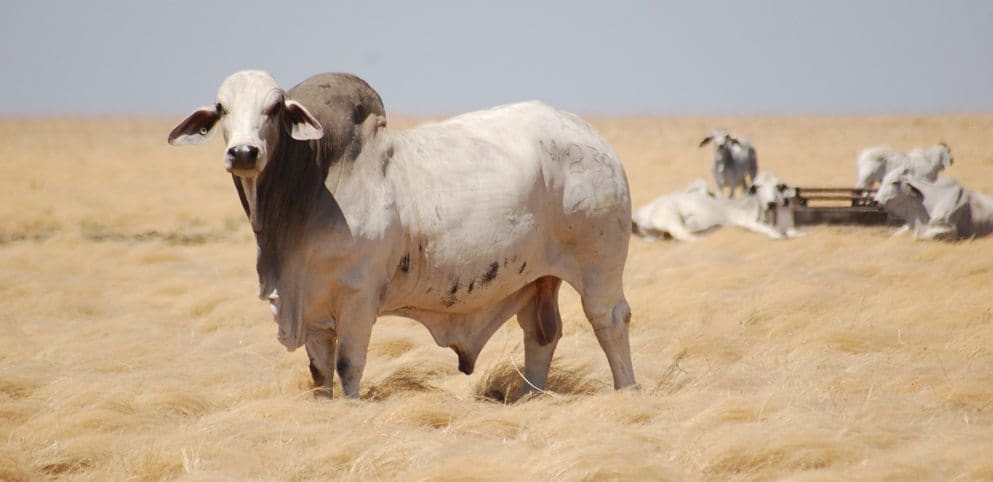
IN natural mating studies conducted in the US and Australia, the percentage of normal sperm in the semen of beef bulls has been consistently shown to be positively associated with either pregnancy rate or calf output.
In a large study conducted in Queensland and the Northern Territory involving 245 tropically adapted bulls multiple-sire mated in 37 mobs, bulls with less than 50pc normal sperm sired few calves, while bulls with the highest calf output had 70pc or greater normal sperm.
Research conducted at Swans Lagoon research station in the Burdekin district in North Queensland demonstrated that bulls with less than 50pc normal sperm not only achieved a lower pregnancy rate after 12 weeks, but they took much longer to get their heifers in calf.
When three or four year-old five-eighth Brahman bulls with less than 50pc normal sperm prior to, and after mating were single-sire mated to two-year-old heifers, the average pregnancy rate achieved each 21 days was 19pc, compared with 48pc for bulls with greater than 70pc normal sperm.
The percentage of normal sperm provides a sensitive measure of the health of the testes and internal sex glands, and is a heritable trait which is also related to female fertility. Further, where males are reared and mated in environments where animals experience seasonal extremes in temperature/humidity, plane of nutrition and parasitism, it can provide a useful indication of how well adapted the bull is to its environment.
Microscopic examination
The assessment of the percentage of normal sperm in a semen sample requires careful microscopic evaluation of the appearance (morphology) of a minimum of 100 individual sperm.
Today, veterinarians conducting bull breeding soundness examinations are able to send preserved samples of semen from each bull examined to dedicated sperm morphology laboratories located across Australia. This laboratory service is unique in the world and has greatly facilitated the routine inclusion of assessment of the percentage of normal sperm in bull breeding soundness examinations.
Crush-side, after collection of a sample of semen, one or more drops are placed in a labelled plastic vial containing 10pc buffered formol saline which preserves the sperm. The preserved samples are then posted/delivered to a sperm morphology laboratory.
At the laboratory a drop of the preserved semen is examined at 1000x magnification using a differential interference contrast microscope. These specialised microscopes are quite sensitive to dust, temperature extremes and moisture and must be operated in a laboratory environment to ensure accurate evaluation of semen samples.
The head, mid-piece and tail of each sperm are carefully examined for the presence of any of 27 abnormalities which have been associated with reduce fertility in bulls. It takes about eight minutes to complete microscopic of 100 sperm, with each sperm morphologist able to accurately examine samples from a maximum of 50 bulls per day.
For each bull sample examined, the sperm morphologist provides a report to the veterinarian detailing the percentage normal sperm and the percentages of specific categories of sperm abnormalities.
In support of standardisation
Recently, The University of Queensland has launched a program to support the standardisation of the process of identifying and reporting sperm abnormalities in bulls.
Where bulls have less than 70pc normal sperm or have greater than the maximum percentage of specific sperm abnormalities, they are likely to be mild, moderate or severely sub-fertile or infertile. These bulls have had, and may be continuing to experience, significant disturbances in the processes of sperm formation and maturation.
Anything that causes a disturbance in the general health and well-being of the bull – for example a disease which causes a rise in body temperature, lameness, or a nutritional stress such as excessive grain intake – can significantly affect sperm formation and maturation, as these disturbances cause a reduction in testosterone in the testes.
As it takes ten weeks for sperm to be formed and mature, then depending on how severe the disturbance in testes function is (based on the report from the sperm morphology laboratory), the veterinarian may recommend the collection of another sample of semen in six to ten weeks’ time.
Finally, one area that often attracts considerable discussion is ‘how long before a sale should bulls be examined to determine percentage normal sperm?’
It is recommended that bulls undergo a breeding soundness examination, including assessment of percentage of normal sperm, about two months prior to sale. Further, it is important that there be no significant change in management of bulls after the breeding soundness examination to ensure that at the time of sale the percent normal sperm in the bull’s semen is similar to what was found when the bulls was examined.

Mike McGowan
* Mike McGowan is the President of the Reproduction Chapter of the Australian & NZ College of Veterinary Scientists, and Professor of Livestock Medicine at the UQ School of Veterinary Science
** Peter McAuliffe is a large animal vet based in Toowoomba, QLD

It would be useful to follow through on high fertility and poor, by blood and hair testing, and trying to get a handle on prior nutrition backgrounds. If any abnormalities or trends show up , it might be able to be managed better, prior to joining.
Perhaps the author of this article would like to explain how the same collection samples of 22 bulls was sent to 3 of the most reputable morphology laboratories in Australia and the results received back were vastly different.Some of the bulls were ranked by certain laboatories to have a below average semen morphology and would have been destroyed.Another laboratory ranked the semen more than acceptable.
There are bulls getting their heads cut off based on what some say is an exact science but clearly the variation in results from these 3 laboratories prove this is not an exact science.
It would be great if this example of 22 bulls being sent to 3 laboratories was increased to say 100 bulls and the results made public.
I ask cattle producers,breed organisations,cattle associations etc to seek more evidence .
I must respond to this article as it contains some incorrect information which results in good bulls being sent to McDonalds for bad reasons.
Basically, it displays a disconnect with current scientific understanding of how sperm defects occur, and their significance.
First, it is simply incorrect that most, or many, are “genetic” in origin. In fact, very few are heritable as such. Some bulls may be more prone to stress effects, e.g. heat, on semen, because of poor scrotal conformation or other contributing traits. However, this is quite different from stating that they have genetic sperm defects, and much caution is advised in making such statements.
In brief, the testicle has limited ways in which it responds to stressors such as heat or toxins, leading to a consistent temporal sequence of abnormal sperm types, which are mostly variations on a theme. Categorising 27 different stand-alone sperm defects is misleading.
The fact is that most sperm defects improve once the stressor is identified and removed (if possible). Many bull breeders are frustrated by misguided morphology results in which bulls are incorrectly “failed”. This leads to unfounded fears and avoidance (if possible) of sperm morphology testing, to the detriment of good cattle breeding and the positive contributions which veterinarians can, and should, make to it.
Supporting information is gladly available on request.
Nice article! And Yes Percentage of Normal Sperm is a heritable trait, which means it can be a target for selective breeding.
Too often sub-fertility in bulls flys under the radar. It manifests itself in females joining up later & later in the season, increasing her chances of PTE & thus the likelihood of her cull from the breeding herd. But the fertility problem was never of her doing. Rather it stemmed from sub-fertility (also infertility) in the bull!! Bull Buyer’s Beware (& get informed!!).